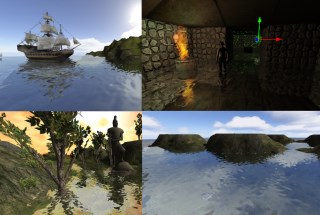

#Coppercube procedural Ps4#
The Forge Cross-Platform Rendering Framework PC, Linux, Ray Tracing, macOS / iOS, Android, XBOX, PS4 Vulkan game engine - material editor, a mix on Unreal blueprint system and Unity shader graph NOTE: a Rendering Library is a layer that Game Engines can use instead of Direct-X or Vulkan or OpenGL so the game can work on more platforms. The entries here have a certain "weight" and are well known.Ĭross-platform, graphics API agnostic, "Bring Your Own Engine/Framework" style rendering library GCanvas also takes advantage of hardware acceleration on most devices, which makes you be able to draw scenes in very high frame rate with Javascript.Ī few listings of important efforts that don't meet the criteria of "download and immediately enter the game creation system" of the other game making systems that are the focus of this documentation effort, but are worth noting in this main listing to be complete.

It supports both graphics 2D and WebGL APIs. It supports hybrid frameworks like Weex, and ReactNative. GCanvas is a hybrid canvas SDK for mobile Apps, which allows you to draw to native devices with Javascript. This feature makes it possible that G3D works not only in browser but also in some hybrid environments like GCanvas (Weex or ReactNative). Compared with other WebGL 3D engines, G3D is a pure render engine, which means it depends on no DOM APIs but just a canvas(or canvas-like) object. G3D is a javascript 3D engine based on WebGL.

This is an important 3D PBR-based engine by Google deisgned for both desktop and mobile that does NOT currently have any "easy to use" entry pointĪ cross-platform, memory efficient, and performant animation system written in C++Ī Cross-end HTML5 Game development solution developed by Alibaba Group (NOTE: this section is here to track any influence by the super large Internet companies, but NONE of these entries fit the casual download, then drag n drop pattern)
#Coppercube procedural for free#
Although OSS, the license requires that you EXCLUSIVELY use Amazons AWS cloud services.Īlthough "sort-of OSS", Epic requires that you signup for free in order to access both the tools and the source. Lumberyard is a modified CRYENGINE packaged with a whole bunch of other stuff to get up and running, including Twitch integration. Hopefully growing reference list, hopefully you find a gem or two here: And that cursor, it just stares back at you. So most of the entries in the list have some sort of environment/editor/tools packaged in a manner to engage and encourage you to give them a try! So in attempting to make " a list of encouraging things" one situation I'm trying to avoid is the writer's block tabula rasa effect of installing a game maker environment and then staring at a blinking cursor in some fancy text editing IDE. The emphasis, originally inspired by the Stardock Video Game Engine article, is to list a range of " gaming enablers" not just raw engines. What makes this list different:There are a zillion game engines both OSS and Commercial, and even the interesting ones are far too numerous to list here. Tools and resources from beginner to expert, listed in order of complicated expert and ending with Stardock Video Game Engine and Super Mario Maker 2 for completely non-technical users. There even seems to be a "book end" pattern to the "secrecy" curtain with both ultra-beginner tools and the AAA tools that create the latest jaw dropping games being closed source.Īll comments and questions are welcome - here we could have a Town Hall for doing stuff with your GPU!īe Human => Make Something, that's what Humans are designed to do! So I will add to a list of game making tools and engines that range from ultra beginner to jaded expert with a small to medium emphasis on OSS tools only because the "magic" going on "behind the scenes" can have the emerald curtain torn away to be revealed with OSS. I was curious about Stardock's decision to enter a rather crowded and possibly small market of casual game making and what sort of journey to larger game engines that road might encourage. Is anything missing? Is anything hard to understand? Please ask questions or comment on anything you find interesting. Also, I'm looking for criticism on the format and content of this information with a view to improving it. But please don't let the size of it make you hesitate from jumping in and adding a comment to just say hello, make a joke, mention which parts look interesting, describe your experience with any of the items listed, rant about the state of gaming etc. NOTE: I am adding a lot of information day to day and I'm now perhaps 50% complete. A Town Hall for Making Stuff with Your GPU


 0 kommentar(er)
0 kommentar(er)
